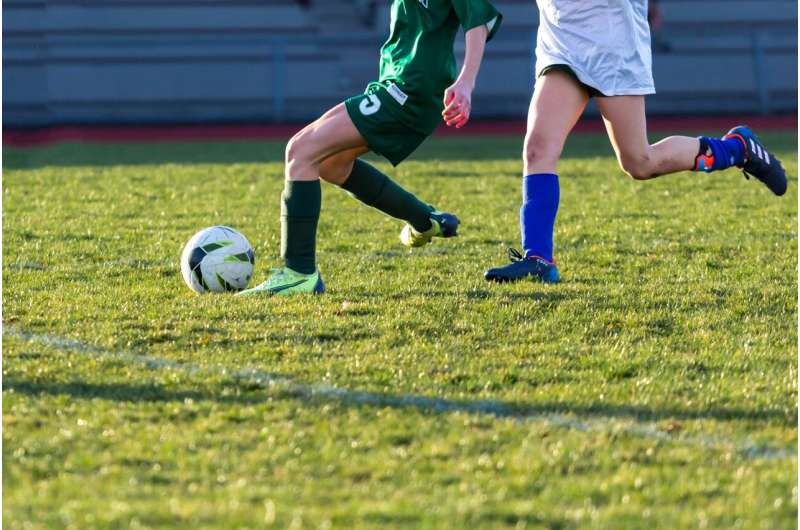This article has been reviewed according to Science X's editorial process and policies. Editors have highlighted the following attributes while ensuring the content's credibility:
fact-checked
trusted source
written by researcher(s)
proofread
More children are getting ACL injuries—here's what could be done to prevent them

There's no doubt that for children and teenagers, taking part in physical activity and sport is hugely beneficial. It improves their health and well-being, creates opportunities for social interaction and builds resilience and leadership skills for life.
However, playing sport can also lead to injury. One particularly nasty sporting injury is damage to the ACL—the anterior cruciate ligament in the knee, which attaches the thigh (femur) and shin (tibia) bones. ACL injuries have rocketed among children in England, and our researchsuggests that one cause of this is that children are not developing basic movement skills, such as jumping and hopping.
Rising injury cases
The ACL plays an important role in providing stability to the knee joint. In particular, it helps prevent excessive forward movement of the tibia and knee joint rotation during movements, such as quick changes of direction during sprinting, pivoting and jump landings. All of these movements are key to many sports.
ACL injury is debilitating at any age, but an ACL rupture experienced during childhood can have lasting consequences for health and well-being. These include the early onset of degenerative disease such as osteoarthritis, a health condition often associated with older age.
When someone experiences an ACL tear or rupture, their knee swells up and becomes unstable. It can become difficult to bear weight and the leg may not straighten properly. Without surgery, the knee will not repair. Recovery from surgery takes nine months to a year, and even then athletes may not be able to return to sport at the same level they played previously.
Historically, ACL injuries have been uncommon during childhood. But over the last 20 years incidence in children has been increasing. Research on ACL surgeries carried out between 1997 and 2017 in England found that they had increased by 22 times in under-20s in this period.
Our recent research has explored the causes of ACL injury in children. In particular, we looked at whether a lack of basic sporting skills could increase their risk.
These skills—known as fundamental movement skills—include running, jumping, hopping, skipping, throwing and catching. Competence in these skills is necessary for more complicated movements, such as the pivots and landings that put stress on the ACL.
Lacking skills
Research by one of us (Michael Duncan) and others shows that British children are not developing these basic skills at the age they should ideally be doing so.
The PE curriculum suggests children should master these fundamental movement skills by the age of around seven years old, but in the UK this mastery does not happen for years after this—towards the end of primary school or even later. We wanted to see if there was a link between this lack of competence and injury risk.
We assessed fundamental movement skills in a group of 98 10- to 13-year-olds who played grassroots football. We then determined their ACL injury risk by assessing the errors they made when performing a high-risk movement—a drop jump—that is associated with ACL injury.
We found that fundamental movement skills explained nearly 50% of the ACL risk score in children. Those children who were classed as "poor" for their landing biomechanics—meaning they were at higher ACL injury risk—had significantly poorer fundamental movement skills compared with their peers.
If children are not becoming sufficiently competent in the broad range of movement skills that are the foundation for sports participation, they are physically unprepared for the demands of sport-specific training and may increase ACL injury risk.
For teachers or community coaches, focusing on these fundamental movement skills first and ensuring children can move effectively may be key in preventing subsequent injury. The development of good movement competence during childhood has the potential to translate to more effective movement later on, reducing the prevalence or severity of ACL injury.
Good quality school physical education and community sports coaching is key to ensuring children develop these fundamental movement skills effectively.
Primary school PE teachers and community coaches need ongoing training in how to teach these skills to children. What's more, there should be enough curriculum time for physical education in schools so that teachers can prioritize the proper development of these fundamental movement skills.
This article is republished from The Conversation under a Creative Commons license. Read the original article.![]()





















